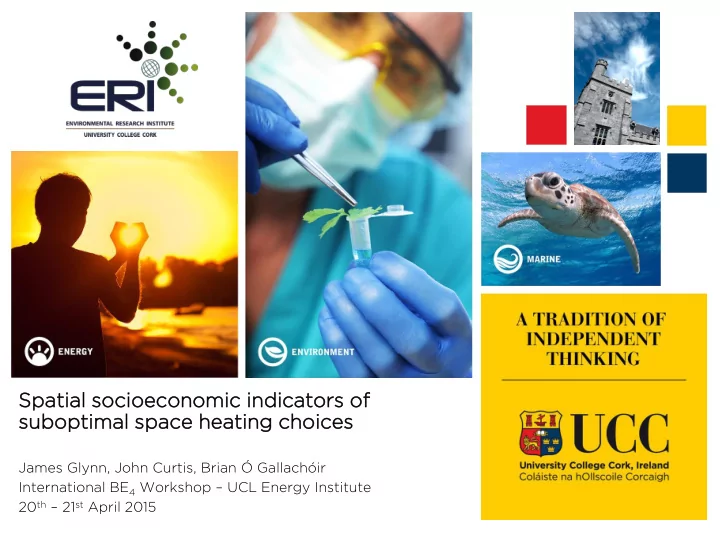

Spati tial al socioec economi onomic indic icat ators ors of suboptimal ptimal space e heatin ting choices ces James Glynn, John Curtis, Brian Ó Gallachóir International BE 4 Workshop – UCL Energy Institute 20 th – 21 st April 2015
Outline • Explore drivers of Energy Poverty in Ireland • Simple Method for comparing spatial socioeconomic and energy infrastructure data • Data driven mapping analysis as opposed to theoretical or statistical frameworks • Need for a socio-economic optimised method for gas grid development • Currently simple population growth based • Capacity utilisation maximisation now an interest • Purpose is to spatially focus surveying for development of an econometric behavioural model for fuel choice • Research objective is to establish & model socioeconomic drivers of residential heating fuel choice and demand
Context • 300,000 Irish households that are currently heavily reliant on peat, coal, or oil have the option to connect to mains gas, within 50m, but choose not to do so even though it would be financially advantageous for them to do so. • 100,000 Irish Households have switched in the last 5 years to more expensive prepaid pricing options • Over € 400 million spent last year on Fuel allowances and Home heating packages • Lowest 20% income households spend ~6% expenditure on Fuel and Light • Lowest 10% income households spend >13% disposable income and Fuel and Light • Spatially heterogeneous home heating choices • Limited success to date with retrofit towards RES-H targets • our understanding of fuel choice behaviour is limited. • this limits our ability to i) understanding fuel choice rationality in Ireland ii) determine future gas network utilisation iii) develop strategies for connecting more households to the gas network.
Dublin Spatial Unit is the Small Area (SA) Cork Galway Galway Limerick Cork Dublin of energy poverty proximal to grid Identify possible fuel switching in areas Gas Networks Ireland Distribution Grids DCENR Gas Transmission Grid Demographic, Social, Labour profile Household Heating Fuels 2011 Census Central of Population poverty Deprivation Index as a proxy for energy Original Rationale: Energy Poverty Data Sets for Comparison • • • • • • • • Limerick
Residential Sector Energy Balance Oil Dominates – Dispersed Low Population Density
Dublin Cork Galway Galway Cork Dublin Limerick Heterogeneous Urban/Rural Central Heating Choices
Coal Imports Affluence Oil product imports building stock Urban areas modern mixed quality Georgian building stock projects Large on going urban renewable Focus on Limerick - Basemap • Third Largest City in Ireland • Population 160,000 Thomand Park Munster Rugby • Mixed Divergent levels of • Mixed Housing Stock Quality Urban Private • Dwellings • City Centre is largely 18 th Century Limerick town centre – • Shopping & Business Apartments • Existing Gas Infrastructure • Deep water port • •
Low Pressure Gas Distribution Grid
Low Pressure Gas Distribution Grid
connections with access Areas of Low Gas to gas grid Gas Central Heating Overview
Oil Central Heating
Electrical Central Heating
Levels of Affluence Cross cutting low gas connections
Low Levels of Affluence
Low BER “EFG” Households
Rental Market
High Proportions of Retirees
Affluence and Building Quality Not the dominant factors we suspected
Age and Rental Markets
Conclusions • Many factors other than price influencing fuel choice and fuel consumption • Are regional division and definition of energy service demands in energy system models accurate enough or appropriate? • Irish TIMES Classification of households • Rural / Urban • Apartment / House • ETSAP TIAM Classification of Household types by sub-regional disaggregation • Socio-demographic parameters could/should be used to define energy service demand drivers and fuel choices • Long Term projections an issue • Targeted surveys required to estimate census variable strength as predictors of fuel choice and energy service demand
Future Work – Econometric Fuel Choice Behaviour • Utilising Individual Geocoded household level census data • “ Household characteristics and the choice of mains gas as a fuel” using bivariate / multi -variate probit type models • “Gas connections by housing estate and associated socio- demographic characteristics” analysis at housing estate level using count data models (e.g. Poisson or Negative Binomial) • “When households connect to mains gas: a socio - economic analysis” using information on the time of gas grid availability and duration/hazard models • “Household fuel choice decisions: a survey analysis” to identify what are the key decision points and barriers surrounding fuel choice and fuel supplier.
Thank You www.ucc.ie/energypolicy
Spati tial al socioec economi onomic indic icat ators ors of suboptimal ptimal space e heatin ting choices ces James Glynn, Brian Ó Gallachóir International BE 4 Workshop – UCL Energy Institute 20 th – 21 st April 2015
percentage of households of low social class percentage of people with a third-level education percentage of people with low educational achievements percentage of households of low social class indicators: Social Class Composition is also measured by five mean number of persons per room mean number of persons per room Labour Market Situation is measured by four indicators: percentage of households with children aged under 15 years and percentage of people with a third-level education percentage of people with low educational achievements headed by a single parent percentage of people aged under 15 or over 64 years of age male unemployment rate percentage change in population over the previous five years female unemployment rate Demographic Profile is measured by five indicators: percentage of households of high social class Trutz Hasse Deprivation Index • • • • • • • • • • • • • • • • •
Galway Cork Dublin Ireland Gas and Elec Grids Limerick
Recommend
More recommend